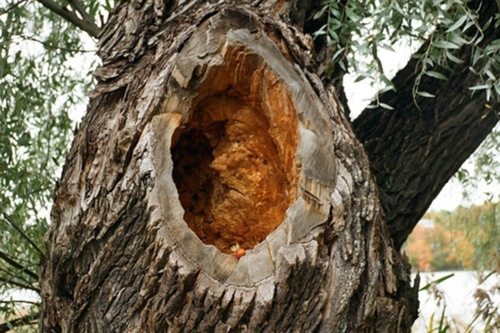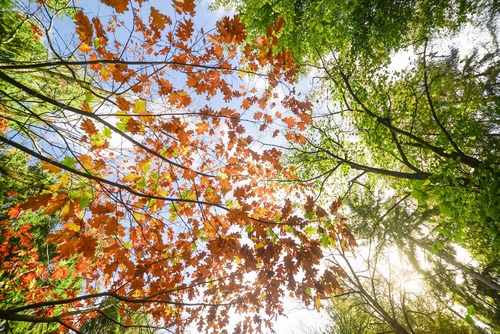The Arborist Now Tree Quiz
Introduction
Are you interested in testing your “tree-teligence”? Take our tree knowledge quiz below and see how well you do!
Each question is multiple choice; scroll down for the answers. We designed this quiz for laypersons, but we have published a quiz for tree professionals too (tree care professionals had better score well on this one!)
1. Which part of a tree actually grows vertically?
a. The base of the trunk
b. The middle portions of the trunk
c. The very top of the tree
d. The top and bottom portions of the tree
2. What is the name of the symbiotic fungus that often lives on tree roots?
a. Armillaria
b. Phloem
c. Mycorrhizae
d. Meristem

An Example of Tree Roots Growing Underground
3. Which of the following pruning practices is harmful for trees?
a. Pruning with a chainsaw in the winter
b. “Topping” a tree by cutting its central leader between nodes
c. Pruning a maple tree in the spring
d. Sterilizing cutting instruments between trees
4. What are meristems?
a. Areas of rapid cell division from which trees grow
b. Areas of dark heartwood surrounded by light sapwood
c. Insect larvae found in a tree’s bark
d. Leaf stems
5. What does the term “transpiration” refer to?
a. The opening and closing of leaves in response to water stress
b. The process by which trees seal off wounds
c. The ability of trees to become dormant during droughts
d. The process by which trees draw water from the ground and release it from the leaves
6. Which of the following characteristics suggests a tree may be hazardous?
a. Dead branches
b. Large hollows, cracks, or cavities
c. Significant lean
d. All of the above

A Tree with a Hollowed Trunk
7. Which of the following is necessary for some pinecones to release their seeds?
a. Drought
b. Torrential rain
c. Fire
d. Insect disturbance
8. Which of the following can reduce a tree’s need for supplemental watering, shield the roots from temperature extremes, and release nutrients into the soil?
a. Fertilizer application
b. Pesticide application
c. Mulch application
d. Antibiotic application
9. Some _______ are the world’s tallest trees, but the world’s most massive trees are ________.
a. Coastal redwoods, giant sequoias
b. Giant sequoias, coastal redwoods
c. Coastal redwoods, Montezuma cypresses
d. Baobab trees, coastal redwoods
10. Trees that shed their leaves every year are called __________, while those that keep a full complement of leaves year-round are called __________.
a. Angiosperms, gymnosperms
b. Stressed, healthy
c. Fruit trees, conifers
d. Deciduous, evergreen

A Grove of Trees Beginning to Show Signs of Autumn Coloring
Answers:
1. C – Trees grow in height at places called primary meristems , which are located at the tips of the shoots.
2. C – Mycorrhizae is the name given to the symbiotic relationship between fungus and tree roots.
3. B – Topping a tree removes the apical meristem and increases the chances that the tree will die.
4. A – Meristems are areas of rapid cell division. Primary (apical) meristems are located at the shoot tips, while secondary (lateral) meristems are located around the circumference of the trunk.
5. D – Transpiration is the pumping of water from the ground to the top of the tree, out of the leaves, and into the air.
6. D – Any of these characteristics may signal that a given tree is hazardous .
7. C – Many fire-adapted pines only release their seeds after ground fires have cleared the earth.
8. C – Mulching reduces evaporation, moderates temperature, and releases nutrients into the soil.
9. A – Coastal redwoods ( Sequoia sempervirens ) are the tallest trees, whereas giant sequoias ( Sequoiadendron giganteum ) are the most massive.
10. D – Deciduous trees shed their leaves regularly, while evergreen trees are always green.
Conclusion
How well did you do? We hope you enjoyed testing your tree knowledge with our quiz!
Whether you’re a budding arborist or just someone looking to spruce up their tree trivia (see what we did there?), remember that learning about trees is an ongoing process. For those in San Francisco looking for expert advice or tree care services, Arborist Now is here to help. Keep exploring, keep learning, and most importantly, keep nurturing the trees that give so much to our environment and communities. Join us as we continue to delve into the fascinating world of arboriculture and share our passion for tree care.
Contact Arborist Now for the answers to all your tree-related questions!
Originally published on May 31, 2016.


